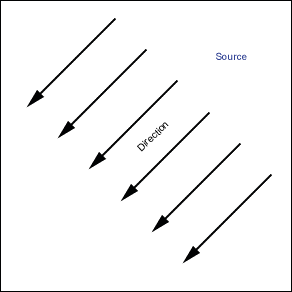Книга: DirectX 8 Programming Tutorial
Types of lighting
Types of lighting
There are four types of lights that you can create in your scene, each of which have their own behaviours and attributes.
Ambient Light
As well as being an attribute of light, you can create a general ambient light level for the scene that is independent of other lights. You can specify how much ambient light there is and what colour it is. You can define the colour by specifying it's red, green and blue (RGB) values.
Point Light
An example of a point light is a light bulb. It has a position but no direction because light is emitted in all directions equally. It also has colour, range and attenuation attributes that can be set. Fig 7.1 below, shows how light is emitted from a point light.

Fig 7.1
Directional Light
Directional lights have direction and colour but no position, an example of a directional light would be something like the sun. All objects in your scene will receive the same light from the same direction. Directional lights do not have range or attenuation attributes. Fig 7.2 below, shows how light is emitted from a directional light.

Fig 7.2
Spotlight
An example of a spot light would be something like a torch. Spotlights have position, direction, colour, attenuation and range. For a spotlight you can define an inner and outer cone each of which has a light value that is blended between the two. You define the cones by specifying their angle, the inner cone's angle is known as Theta and the outer cone's angle is known as Phi. You define how the illumination between a spotlight's inner and outer cone changes by specifying the lights Falloff property. Fig 7.3 below, shows how light is emitted from a spot light.

Fig 7.3
All lights add a computational overhead to your application, some more than others. The light with the least overhead is ambient light, followed by directional lights, then point lights and finally, the lights with the most overhead are spot lights. Think about this when you are deciding what lights to use in your application.
- DirectX Tutorial 7: Lighting and Materials
- Attributes of a light
- DirectX Lighting vs. Real World Lighting
- Appendix C. ICMP types
- 10.3.2 Automatic Highlighting and Coloring
- Perl Variable Types
- Types of Kernels
- Mixing Different Parameter Types
- 3.1.7 Variable Types
- 4.1.1 Function Prototypes
- 8.3.2 Data Flow Types
- 9.6 Types of Errors




